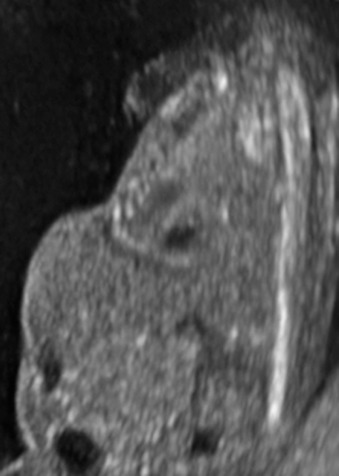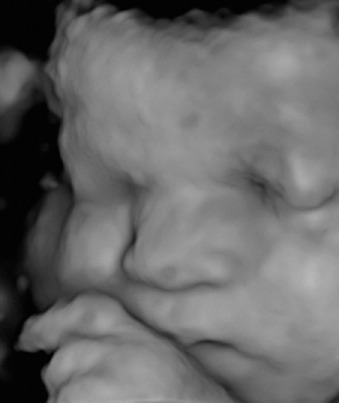Abstract
Fibroblast growth factor receptor 3 (FGFR3) disorders are a group of disorders that include thanatophoric dysplasia, achondroplasia, and hypochondroplasia. Achondroplasia is the most frequent cause of nonlethal dwarfism and is characterized by relative macrocephaly, characteristic facies, shortened long bones, relative long trunk and a distinct form of brachydactyly associated with a trident configuration to the hand. Many of these findings can be detected by prenatal ultrasound. Thanatophoric dysplasia is one of the most common lethal skeletal disorders and is associated with relative macrocephaly, frontal bossing, severe micromelia, and small, lethal appearing thorax. Achondroplasia and thanatophoric dysplasia are inherited as autosomal dominant disorders due to heterozygosity for mutations in FGFR3 .
Keywords
achondroplasia, hypochondroplasia, thanatophoric dysplasia, fibroblast growth factor receptor 3, FGFR3
Introduction
Fibroblast growth factor receptor 3 (FGFR3) disorders compromise of a spectrum of disorders that include thanatophoric dysplasia, achondroplasia, and hypochondroplasia, among other rare disorders such as severe achondroplasia with developmental delay and acanthosis nigricans (SADDAN), and craniosyntoses syndromes. They are all inherited as autosomal dominant disorders due to heterozygosity for mutations in FGFR3 . Achondroplasia is the most frequent cause of nonlethal dwarfism and is characterized by relative macrocephaly, characteristic facies, shorted long bones, long trunk, and a distinct form of brachydactyly associated with a trident configuration to the hand. Because of nonassortative mating in the dwarf community, homozygosity for achondroplasia mutations are seen and frequently associated with a high degree of perinatal lethality.
Disorder
Definition
Thanatophoric dysplasia, achondroplasia, and hypochondroplasia were historically recognized as distinct disorders with overlapping features. With the discovery of FGFR3 as the disease gene for all three disorders, they are now considered a “bone family.” All three disorders are osteochondrodysplasias characterized by varying degrees of skeletal abnormalities. Thanatophoric dysplasia is lethal without very aggressive interventions. Achondroplasia is nonlethal with some rare exceptions. Hypochondroplasia can phenotypically mimic achondroplasia but is usually milder. In hypochondroplasia, transmission is autosomal dominant, and most cases are the result of heterozygosity for de novo mutations in the FGFR3 gene. Thanatophoric dysplasia and achondroplasia can be detected by prenatal ultrasound (US), and hypochondroplasia, while milder, may be detected prenatally, particularly when there is an affected parent.
Prevalence and Epidemiology
Precise incidences of these disorders are not truly known, but they are among the more commonly seen skeletal disorders and are estimated at 1 in 20,000. They result from dominantly inherited mutations, and there is no ethnic or racial predisposition. Most cases are the result of de novo mutations, seemingly only from the paternally derived allele. The risk of FGFR3 disorders increases with advanced paternal age. The chance of phenotypically normal parents having a second affected child is very low, but can occur due to germline mosaicism. Homozygous achondroplasia occurs in one-quarter of the offspring of two affected parents.
Etiology, Pathophysiology, and Embryology
Thanatophoric dysplasias, achondroplasia, and hypochondroplasia all cause gain of function mutations in the gene that encodes for FGFR3. Recurrent mutations have been seen for all three disorders, allowing for targeted gene analysis. In achondroplasia, most of the patients carry the mutation p.Gly380Arg.
FGFR3 disorders result from activating mutations in the receptor leading to abnormal proliferation and regulation of growth plate chondrocytes, and conasequent poor endochondral growth. The degree of gain in FGFR3 function correlates with phenotypic severity.
To date, all FGFR3 mutations appear to be paternally derived, due to a selective advantage to sperm that carry the mutations within the pool of sperm. This mutation increases in frequency with advancing paternal age.
Manifestations of Disease
Clinical Presentation
Thanatophoric dysplasia presents with macrocephaly, a large anterior fontanel, frontal bossing, a flat facies with a depressed nasal bridge, ocular proptosis, marked shortening of the limbs (micromelia), brachydactyly with trident hands (short hands with fingers of equal length and an increased space between the third and fourth digits), redundant skin folds, narrow bell-shaped thorax with short ribs and protuberant abdomen, hypotonia, bowed femurs, and in some cases cloverleaf skull due to craniosynostosis. Radiographic features include craniosynostosis in some cases, shortening of the long bones with irregular metaphyses and platyspondyly (flat spine on lateral view).
Achondroplasia presents with rhizomelic (proximal) shortening of the arms and legs with redundant skin folds, limitation of elbow extension, brachydactyly with trident hands, bowed legs, relative macrocephaly with frontal bossing, and depressed nasal bridge. Radiographic findings include short, thick tubular bones, narrowing of the interpediculate distance of the caudal spine, rounded ilia and horizontal acetabulae, narrowing of the sacrosciatic notch, proximal femoral radiolucency (fade out), and mild metaphyseal flaring. Individuals with homozygosity for achondroplasia mutations share radiographic features with thanatophoric dysplasia.
Hypochondroplasia is milder than achondroplasia and frequently not immediately recognized at birth, and only recognized in the toddler period. Clinical findings then include short stature, stocky build, shortening of the proximal (rhizomelia) or middle (mesomelia) segments of the extremities, limitation of elbow extension, brachydactyly (but not typically trident), mild joint laxity, and macrocephaly with relatively normal facies. Radiographic findings are similar to achondroplasia, but are milder.
Imaging Technique and Findings
Ultrasound.
US findings for thanatophoric dysplasia include severe shortening of all the appendicular bones, which can be seen as early as the late first trimester, as well as an increased nuchal translucency. Significantly, by the second trimester there are very short and frequently bowed but well-mineralized bones, a narrow chest with short ribs ( Fig. 50.1 ), relative macrocephaly with an abnormal facies (flat nasal bridge and frontal bossing) ( Figs. 50.1 and 50.2 ), and brachydactyly with trident configuration ( Fig. 50.3 ). Other reported US abnormalities include ventriculomegaly and other brain abnormalities, as well as frequent third trimester polyhydramnios.












